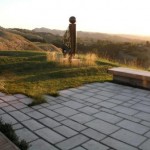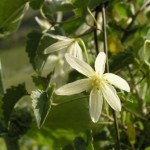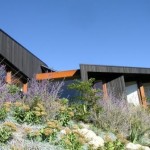Influencing Design – Te Mata Peak Garden Case Study
by Philip Smith, O2 Landscapes
Te Mata Peak in Hawke’s Bay is a special place; near its top, a network of spectacular cliffs and soft hillsides supports a distinctive range of plant species, including species found nowhere other than on the Peak itself.
In addition to this, the foothills upon which the house of our clients sits bear the marks of a long history of human occupation.
Working with the local flora
The plants of Te Mata Peak play a significant role in the design of the garden that we designed. Perhaps the most important of these is the critically endangered Te Mata ‘native daphne’ (the romantically-titled Pimelea aff. aridula (iv)); a plant recently described as being in serious danger of extinction. Fortunately for it, a local group is committed to replanting it on the Peak, off seed from plants that were collected more than 40 years ago.

Te Mata Pimelea
The Te Mata Pimelea grows amongst shrubs and grasses in a very small number of sites on the limestone faces of Te Mata cliffs. Within the garden, we have planted around 80 specimens of it in various spots. It is establishing very well, and we intend to plant even more plants in the future, to help establish an ‘insurance’ population of this unique local native on the foothills of its native habitat.
An additional strand of the garden design concerns an interest that we have held for some time – in the trialling of native grasses which have the character of pasture grasses (as opposed to the usual perception of a native grass as bearing a tussock form). The dry hills of this area are a habitat within which native species have been able to endure within pasture, due to their ability to survive in unimproved soil. We have utilised such species extensively (including meadow rice grass, Microlaena stipoides); especially for the purpose of meadow zones, which act as an alternative to garden edging (they form a gradual transition between lawn and garden).
An East Coast Hebe (H. stricta var. macroura), which Oratia Native Plant Nursery collected from the vicinity of Napier, is planted in association with Microlaena stipoides, at the top of one slope. Its compact, spreading form and attractive foliage make it the finest Hebe species that we have ever used.
‘Archaeological’ paving patterns
During the design process, it was important to us to investigate possibilities related to the local limestone geology. Our early thoughts centred around potentially working hard limestone similar to Arts and Crafts style stonework (and early examples of perfunctory paving from historic sites within New Zealand).
However, the clients came across a locally-produced reconstituted limestone concrete paver (produced by Hawkes Bay Paving Company Ltd.), and suggested looking into this material. Products made in this manner do not normally appeal to us, but the process of finishing (scabbling) and attention to detail applied by the manufacturers make this a very worthwhile, interesting material. A change in material often necessitates a change in approach, and the use of this ‘hybrid’ material (neither purely artificial nor natural) led us to pursue new thoughts.
We researched further, and came across two distinct influences that informed the final design. Firstly, we coincidentally discovered the paving designed by Dimitris Pikionis opposite the Athens Acropolis (whilst reading through the recipients of the Carlo Scarpa Prize for Gardens; a scheme run by the inspirational Italian institute, Fondazione Benetton Studi Ricerche). Pikionis utilised a profound understanding of Greek artistic traditions and vernacular landscape forms, and Japanese aesthetics, to formulate his own ‘form grammar’; thereby creating a remarkable piece of landscape design which was both progressive and rooted in local tradition.
Pikionis’ example inspired us to look into establishing our own ‘form grammar’ for the paving on this site. The second influence upon our eventual patterns was a document prepared by the Department of Conservation, containing aerial surveys of archaeological sites at Porangahau in the southern Hawkes Bay (pre-European Māori settlement).
These provided beautiful abstract compositions, with their own sense of order – as distinct from the comparatively strict geometric order traditionally applied to European colonial settlement patterns. They are the result of a very direct response to settling within the landscape. Our clients also lived and worked at Porangahau for many years, so there is an intimate connection for them to the application of patterns derived from that area.
The paving represents a method of working that we feel very strongly about; the application of vernacular form into design. The eventual design needed to walk a line between faithful representation of the forms and patterns from Porangahau, and the abstraction of certain areas of the paving, so that the overall scheme was cohesive. Our work with Auckland artist, Michael Shepherd, was integral in determining the finishing methods for the paving surface, as Michael has a highly developed perspective on artistic process.
Combining natives with flowers
On the southeastern side of the property, the ‘integrated’ native/flower border is designed as a series of pseudo-formal islands (of native shrubs. These provide the structure in which we have interplanted flowering perennials and shrubs that are well adapted to the extremely dry conditions that occur in Hawkes Bay summers.
The native species that form the structural ‘islands’ include Melicytus obovatus, Melicytus crassifolius, Olearia nummulariifolia, nd an unnamed species of Melicytus from limestone areas of northwest Nelson. These will be pruned to orderly forms, but not trimmed in the manner of hedges. The result will be undulating cloud-like plant forms, which provide a loose manner of formality (similar to the approach of the Belgian landscape architect, Jacques Wirtz). A native scented Clematis – C. forsteri – which is often associated with limestone areas (and is found on Te Mata Peak), is planted to wind through these shrubs and provide seasonal interest.
Amongst these ‘islands’, perennial species emerge from spring through to autumn; including Russian Sage (Perovskia atriplicifolia), a sub-shrub that sends up lilac spires, whose colour intensifies throughout summer to a vibrant dark purple colour. Bearded irises are a conspicuous feature of the lower section of the border, and an unusual South African bulb, Bobartia indica, creates a differing sense of structure with its reed-like, dark green foliage.
A plant that we have been fortunate to acquire is the Mediterranean sea squill, Urginea maritima; which is one of countless perennial or bulb species that are now ignored by the landscape industry in favour of static, safe compositions. Thankfully, we were able to buy material from Bev McConnell’s wonderful Auckland garden, Ayrlies.
As a final note, upper reaches of the garden contain significant number of another of our native limestone-country treasures, the Marlborough rock daisies (Pachystegia insignis and P. insignis x rufa).
- Terrace sculpture
- Irises and South African bluebells
- Te Mata Pimelea
- East border






